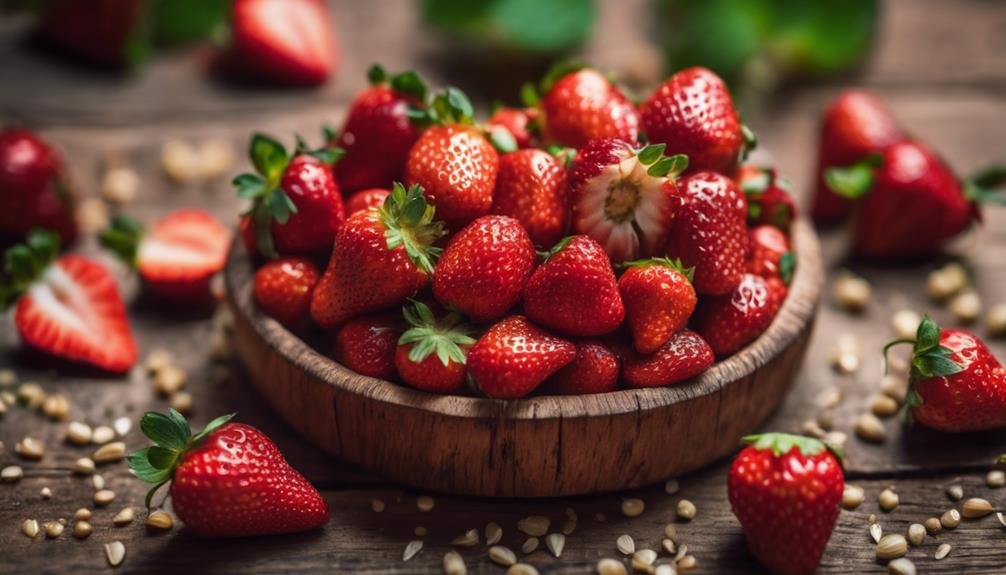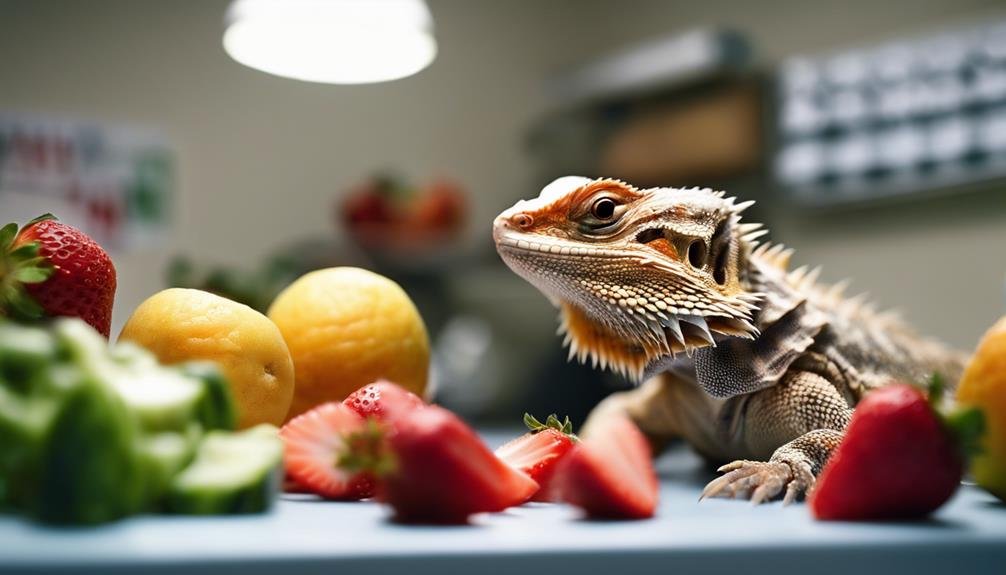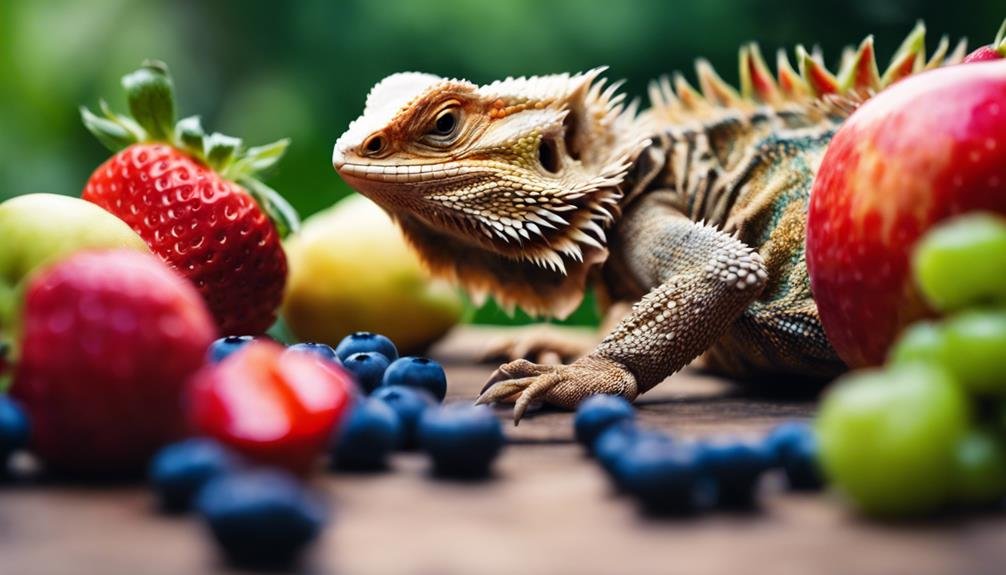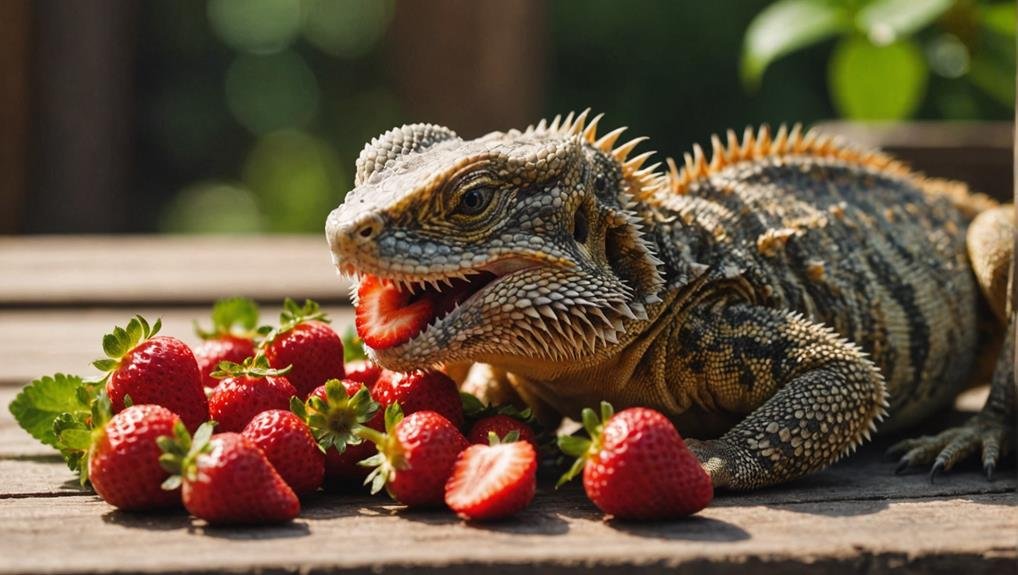You might wonder if it’s safe to give your Bearded Dragon strawberries. While strawberries are packed with water, vitamins, and essential nutrients, they should only be an occasional treat. Feeding them too often can lead to obesity and dietary imbalances due to their high sugar content. Preparation is key—washing, removing stems, and cutting them into small pieces guarantees your pet can enjoy this treat safely. But what about other fruits? How do strawberries compare to the rest? Let’s explore how to maintain a balanced diet for your Bearded Dragon and the role strawberries play in it.
Key Takeaways
- Bearded dragons can eat strawberries but only as an occasional treat.
- Limit strawberries to once a week due to high water and sugar content.
- Wash thoroughly, remove stems, and cut strawberries into small, bite-sized pieces.
- High sugar content in strawberries can lead to obesity and dietary imbalances.
- Mixing strawberries with calcium-rich foods can help mitigate health risks.
Nutritional Content of Strawberries


When considering strawberries, you’re considering a fruit packed with water, vitamins, and essential nutrients. Bearded Dragons eat strawberries occasionally, and there’s good reason for that. Strawberries have a high water content, about 90.95%, which helps keep your bearded dragon hydrated. This is important as hydration plays a significant role in their overall health.
Regarding nutritional value, strawberries provide 32 calories per 100g serving. They’re low in fat, contain just 0.3%, and offer about 0.67% proteins. Rich in potassium, with 153mg per serving, and loaded with Vitamin C, providing 58.8mg, strawberries contribute to various bodily functions, including immune support.
However, when feeding strawberries to your bearded dragon, it’s important to know their calcium and phosphorus content. Strawberries have a skewed calcium-to-phosphorus ratio, which means they shouldn’t be a regular part of their diet but can be an occasional treat.
Always cut strawberries into smaller pieces to prevent choking and aid in digestion. This way, your bearded dragon can enjoy the benefits without any issues.
Feeding Frequency
To guarantee your bearded dragon stays healthy, limit strawberry treats to no more than once a week. This importance is essential because while bearded dragons can eat strawberries, feeding them too often can disrupt their dietary balance. When you feed strawberries to your beardie, it’s vital to remember their high water and sugar content.
Offering strawberries as an infrequent treat ensures your bearded dragon avoids potential health issues. Balancing their diet with foods rich in calcium and low in phosphorus helps prevent metabolic bone disease, a common concern among bearded dragons. Remember that a varied beardies diet is the key to good health. Here’s a quick guide to help you plan:
| Frequency | Pros | Cons |
|---|---|---|
| Once a week | Treats are enjoyable | None if balanced with other foods |
| More than once | More Variety | Risk of digestive issues |
| Daily | High water intake | Nutritional imbalances |
| Never | No risk of excess sugar | Missed enrichment for your pet |
Modifying how often bearded dragons eat strawberries helps prevent digestive problems and ensures they get the necessary nutrients. By following these guidelines, you’ll maintain a balanced and healthy diet for your bearded dragon.
Health Risks


Feeding your bearded dragon strawberries too often can lead to several health risks. First, strawberries have a poor calcium-to-phosphorus ratio, which can cause metabolic bone disease in your pet. This condition weakens their bones due to an imbalance where phosphorus inhibits calcium absorption. Without enough calcium, your bearded dragon’s bones can become brittle and prone to fractures.
Another concern is strawberries’ high sugar content. Regular consumption can lead to obesity and other sugar-related health issues in bearded dragons. Excess sugar can disrupt their essential dietary balance, leading to long-term complications.
Strawberries also have a high water content, which might seem hydrating but can pose a dehydration risk. The excess water can lead to diarrhea, causing your bearded dragon to lose crucial fluids and electrolytes.
Moreover, the acidity of strawberries, with a pH of around 3.3, can be harsh on your bearded dragon’s mouth and digestive system. The acidic nature can cause mouth sores and discomfort during digestion.
To mitigate these risks, consider mixing strawberries with calcium-rich foods like kale or arugula to offset the acidity and improve the calcium-to-phosphorus ratio.
Preparation Methods
Proper strawberry preparation guarantees your bearded dragon a safe and healthy treat. Start by washing strawberries thoroughly to remove any chemicals or residues. This step is essential, as residues can be harmful to your pet. After washing, remove the stems and leaves, as these parts aren’t suitable for beardies.
Next, cut the strawberries into small, bite-sized pieces. Each piece should be smaller than the distance between your bearded dragon’s eyes to avoid choking hazards. The table below outlines the key preparation methods:
| Preparation Step | Reason | Notes |
|---|---|---|
| Wash strawberries | Remove chemicals/residues | Use clean water |
| Remove stems/leaves | Unsuitable for diet | Discard properly |
| Cut into small pieces | Prevent choking | Size < distance between eyes |
| Ensure small size | Avoid digestive issues | Monitor intake |
Remember that strawberry pieces should be of the appropriate size to prevent digestive issues. While strawberries are a sweet treat, they contain natural sugar, so feed them in moderation. Incorporating strawberries into your bearded dragon’s diet can be a delightful and nutritious addition, provided you adhere to these preparation methods. This guarantees your pet enjoys a safe, delicious snack without any risks.
Other Suitable Fruits


In addition to strawberries, you can treat your bearded dragon to various other fruits like apples, blueberries, mango, papaya, and watermelon. These fruits add different flavors to your dragon’s diet and provide important nutrients. Rotating these fruits guarantees your pet a balanced and enjoyable feeding experience.
When introducing these fruits, it’s important to be mindful of their nutritional content. Apples, for example, are a good source of fiber and vitamin C, while blueberries are rich in antioxidants. Mango and papaya offer vitamins A and C, essential for your dragon’s health. Watermelon, on the other hand, provides hydration due to its high water content. However, always remember to remove any seeds and avoid fruits with high acidity, as they can interfere with calcium absorption, which is critical for your dragon’s bone health.
For those with a baby beardie, you might’ve asked questions about the best fruits for younger dragons. While they can eat these fruits, it’s important to offer them in moderation and ensure they’re finely chopped to prevent choking. Variety helps prevent nutritional deficiencies and keeps your bearded dragons interested in their diet.
Conclusion
You can treat your Bearded Dragon to strawberries, but remember to do so sparingly.
Limiting their strawberry intake to once a week and guaranteeing proper preparation will keep your pet healthy and happy.
While strawberries offer great nutritional benefits, overindulgence can lead to health issues like obesity.
So, mix in other suitable fruits to maintain a balanced diet and make sure your Bearded Dragon thrives.


